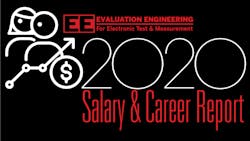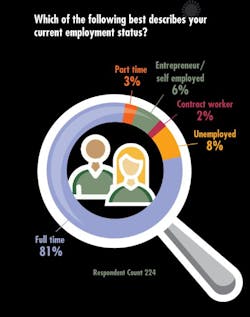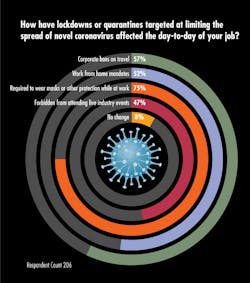Takeaways From Endeavor Media’s 2020 Salary Survey Show the State of Evaluation Engineering
There’s a saying that every animal loves a mirror, and in its way, the design and development engineering community is a living thing. Recently the parent group of Evaluation Engineering, Endeavor Media, conducted a detailed survey amongst its readership, creating a current reflection of the engineering industry. This information covers not only salaries and financial insights, the survey also had questions about how people are engineering in these interesting and challenging times.
More than 200 engineers answered the call to tell us about their working lives and the relationship with the industry and the companies they work for. Several dozen questions, ranging from job and career to workplace and COVID-19, obtained a snapshot of the state of the engineer today. Along with the other great publications at Endeavor like Electronic Design, we at Evaluation Engineering will be presenting our takeaways from the data provided.
First-glance impressions
One thing about the survey came across immediately, and that is the age and gender of the survey respondents. The predominance of older males in the engineering industry speaks as much to the difficulty in acquiring the knowledge and experience to pursue a career in engineering design as it does to societal issues we do not feel capable of addressing in these pages.
Having said that, input from hundreds of engineers does give us real insight into the state of affairs. The respondents came from states across the country, in a range of industries and a variety of positions. These are engineers working actively in the field, and have observations and insights important to understanding the current situation in the marketplace.
Our first question we asked was about employment status, with over 80% reporting they were actively working. One could say this is a pretty consistent 80/20 split between people actively working, and people with industry expertise looking for work, as the number doesn’t reflect the people trying to enter the industry.
When it comes to what our readers are doing, roughly half stated they were directly involved in design & development engineering. The rest of the respondents came from a variety of verticals, from process engineering to management. Titles ranged from CEO/Owner/President to consulting engineers. Over 95% of the working respondents said they had the same position they held the previous year.
The New Work Environment
One of the biggest factors impacting the modern work environment is the quarantine procedures thrust upon us by the COVID-19 pandemic. Being forced to stay home, and stay apart when allowed to go out, has completely changed the business landscape. Trade shows now have to be held online, and even in the future will continue to have a significant internet aspect. Wherever possible, companies are restricting travel, having employees work remotely, and adopting collaborative-work software packages to aid team development of products and services.
The engineering community was already migrating toward a collaborative development environment, as it is one of the only practical ways to conduct product development with an international team. However, this “perfect storm” of isolation has forced everyone to adopt such telepresence workplace solutions.
Having said that, the survey showed that over 40% of our respondents said they still work from their office, with only a third of the engineers responding saying that they work more from home now. This relatively high percentage, as sources such as Stanford Research say over 40% of the U.S. labor force are now working from home full-time. This is probably due to the need for the specialized equipment that can only be found at the office, and can’t be brought home.
Regarding direct actions to address COVID-19, roughly two-thirds of the respondents said their company put a travel ban in place, and about half forbade employees from attending industry events. More than half of the companies involved have imposed work-from-home mandates, and over three-quarters implemented mandatory mask rules in the office. Only about 10% of respondents said no actions were taken at all to address the situation.
Economic issues
Beyond the day-to-day challenges of simply doing business, the problems of dealing with COVID-19 and their impact extend into financial situations and human resources. Companies and individuals must also adjust their approach to manage the disruption to the marketplace. The loss of revenues due to the various forces stemming from the tumult of the coronavirus reaction are serious, and must be addressed.
Beyond layoffs and furloughs, some of our readership were hit in the wallet. About 40% of our audience had salary reductions due to cost-cutting, with two-thirds reporting wage freezes, and half of the companies involved freezing bonuses. Even stock options have taken a tumble, with almost a fifth of respondents reporting hits to their company portfolio.
Major takeaways
We got so much information, we will be doing another report with a drill-down on thoughts on what the results mean for the test and evaluation community in particular, but first we’ll give you our take on the above information and what we feel may be derived from it.
The engineering community has taken a series of hits, but as a whole is generally sound. Most engineers responding said they were still working, with a high percentage reporting little or no work or financial impact from the coronavirus situation. This is probably due to the high level of skill and resource investment involved in product development, so while new projects were cancelled, ongoing projects must go on.
Also, the forward-looking nature of design engineering is its own challenge, as reduction of investment often directly leads to loss in competitive IP development as well. If you stop your R&D efforts, those competitors that didn’t will wind up eating your lunch. This also is probably the reason there is such a relatively high percentage of engineers working from the office, as the high-level development going on there can’t be stopped.
The economic aspects are harder to judge going forward, as that is one of the areas most fluid in its changing situation. Tightening the belt is all fine and good, but there needs to be new business for the company to stay viable. This market uncertainty is the greatest variable in the whole equation, and what impacts every other aspect. Now that companies have taken steps to address the current situation, they must start to develop ways to do business and stay profitable in this new market reality.
About the Author
Alix Paultre
Editor-at-Large, Electronic Design
An Army veteran, Alix Paultre was a signals intelligence soldier on the East/West German border in the early ‘80s, and eventually wound up helping launch and run a publication on consumer electronics for the US military stationed in Europe. Alix first began in this industry in 1998 at Electronic Products magazine, and since then has worked for a variety of publications in the embedded electronic engineering space. Alix currently lives in Wiesbaden, Germany.
Also check out his YouTube watch-collecting channel, Talking Timepieces.




